Historic Aerospace Sites
2013 Dedicated Historic Sites
Kitty Hawk, NC
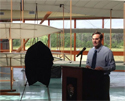
19 August 2013: On 19 August, the AIAA Historic Aerospace Sites Committee dedicated Kitty Hawk, NC, as a historic aerospace site, following a decades-long negotiation with the U.S Park Service. A historic marker was unveiled at a 0930 hrs ceremony as part of the First Flight Society’s National Aviation Day at Kitty Hawk. At this site on 17 December 1903, Orville and Wilbur Wright achieved the first sustained, controlled heavier-than-air flight of an aircraft, opening a new era of transportation throughout the world. Their pioneering spirit continues to inspire succeeding generations to dream, aspire, innovate, and create without limits. A full-scale replica of the Wright Flyer made by the AIAA National Capital Section is on display at the pavilion at the Wright Brothers National Monument, which is part of the park. Park information can be found at www.nps.gov/wrbr/index.htm.
Pitcairn Field

1 June 2013: The AIAA Historic Aerospace Sites Committee dedicated Pitcairn Field, in Willow Grove, PA, as an AIAA Historic Aerospace site, during an 11:00 a.m. EDT ceremony on Saturday, 1 June. On this site, on 18 December 1928, Arthur Rawson, followed by Harold F. Pitcairn, flew a Cierva C.8W Autogiro. This was the first successful rotary wing aircraft to fly in America. Pitcairn Field – Willow Grove became the center of American Autogiro development and manufacture. Pitcairn and his associates were awarded the 1930 Collier Trophy. The development of the helicopter in America was made possible in part by the rotary-wing patents held by Pitcairn.
2012 Dedicated Historic Sites
Bell Aircraft Manufacturing Plant

14 August 2012: On 14 October 2012, The AIAA Historic Aerospace Sites Committee designated the Bell Aircraft Manufacturing Plant, in Wheatfield, New York, as a Historic Site. The ceremony took place at the Calspan Corporation facility. The Bell Aircraft Corporation was an aircraft manufacturer that designed and built several types of fighter aircraft during World War II, but is most famous for the Bell XS-1, the first aircraft to break the sound barrier. It is recognized for the development and production of America’s first jet fighter and many other successful X series of aircraft. The Bell 47 helicopter and military helicopters changed the world of vertical flight. Critical contributions to the space program include the rocket engine that lifted Apollo astronauts from the lunar surface.
Pearson Airfield

8 September 2012: The AIAA Historic Aerospace Sites Committee designated Pearson Airfield, in Vancouver Washington, as a Historic Site. Pearson Field is one of the oldest operating airports in the United States and served as a major military airfield in the interwar years. In 1905, a dirigible originating from the nearby Lewis and Clark Centennial Exposition landed at Fort Vancouver Polo grounds, initiating an enduring and illustrious connection to aeronautics and record-breaking endurance flights. Starting in 1923, the airport played a key role in the development of U.S. Air Power and general aviation in the Pacific Northwest. The dedication ceremony occurred on Saturday, 8 September 2012. (Image: Gelantine was a privately owned, corporately sponsored dirigible, built by Thomas Scott Baldwin's company Baldwin's Airships, Balloons, Aeroplanes of New York City. On the morning of September 19, 1905, the Gelatine, piloted by Lincoln J. Beachey, ascended from the grounds of the Lewis and Clark Centennial Exposition on the shores of Guild's Lake in Portland, Oregon, landing 40 minutes later at the Vancouver Barracks (Pearson Airfield today) in Vancouver, Washington. The flight is considered the first aerial crossing of the Columbia River and the first account of controlled powered flight in Washington. Credit: Pearson Air Museum).
2011 Dedicated Historic Sites
Bremen Airport
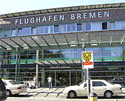
6 October 2011: The AIAA Historic Aerospace Sites Committee designated the Bremen Airport, in Bremen, Germany, as a Historic Aerospace Site. A historic marker was unveiled on 6 October during a 1:00 p.m. ceremony at the airport in the Bremmenhalle, the airport’s exhibition hall, located on the roof of Terminal 3. Bremen Airport was founded in 1909. In 1924, German aviation pioneers Henrich Focke and Georg Wulf founded the Focke-Wulf company on the site. On 26 June 1936, Henrich Focke’s Fw 61, the world’s first fully operational helicopter, made a successful maiden flight at the airport, piloted by Ewald Rohlfs.
Site of Thaddeus S.C. Lowe’s 1861 Balloon Reconnaissance Demonstration Flight and Aerial Telegraph Transmission
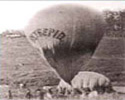
11 June 2011: The AIAA Historic Aerospace Sites Committee designated the site of Thaddeus S.C. Lowe’s 1861 balloon reconnaissance demonstration flight and aerial telegraph transmission as a Historic Aerospace Site. The site is on the National Mall, in front of the Smithsonian Institution’s National Air and Space Museum. A historic marker was unveiled during the Air and Space Museum’s celebration of Civil War history, which took place Saturday, 11 June on the National Mall. (Pictured: The Civil War balloon Intrepid. Credit: National Air and Space Museum.
2010 Dedicated Historic Sites
Central Yacht Basin in St. Petersburg, Florida
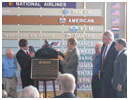
29 October 2010: On Friday, 29 October 2010, The AIAA Historic Aerospace Sites Committee designated the Central Yacht Basin in St. Petersburg, Florida, as a Historic Aerospace Site. The Yacht Basin is the site of the first commercial airline flight in the world, on 1 January 1914. The first passenger was Abraham C. Pheil, a former St. Petersburg mayor, and the pilot was Tony Jannus. The Tony Jannus Distinguished Aviation Society honors achievements in aviation in his name. In the photograph, AIAA Region II Director Alan Lowery and the current St. Petersburg mayor Bill Foster unveil the plaque as members of the Tony Jannus Society and the Florida Aviation Historical Society look on. Randal Allen, the Central Florida section chair, is third from right.
Cornell Aeronautical Laboratory (known today as Calspan)
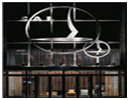
1 December 2010: On Wednesday, 1 December 2010, The AIAA Historic Aerospace Sites Committee designated the Cornell Aeronautical Laboratory (known today as Calspan), in Buffalo, New York, as a Historic Aerospace Site. The facility started as a research facility for the Curtiss-Wright company and was donated to Cornell in 1946. Since then, this facility has touched every aspect of aviation and space research. Every military aircraft and space vehicle developed in the United States from the end of World War II to present day has been tested at this facility.
Tidbinbilla, Honeysuckle Creek and Orroral Valley Tracking Stations
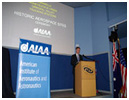
25 May 2010: AIAA Immediate Past President Dave Thompson designated the Tidbinbilla, Honeysuckle Creek and Orroral Valley Tracking Stations outside Canberra, Australia, as Historic Aerospace Sites. The three stations were established to support NASA’s Deep Space Network, Manned Space Flight Network and Spacecraft Tracking and Data Acquisition Network. Among other notable achievements, these stations played a key role in supporting the Apollo 11 Moon landing, with the Honeysuckle Creek station providing the first historic pictures of man walking on the Moon on 20July 1969 (21 July 1969, in Australia), as well as voice and telemetry contact with the lunar module. The ceremony was attended by AIAA members, current and former tracking station employees, and the U.S. Ambassador to Australia, who praised Australia’s contributions to the space program.
NASA/North American/Boeing Industrial Site
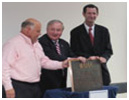
21 May 2010: The AIAA Historic Aerospace Sites Committee designated the NASA/North American/Boeing Industrial Site in Downey, California as an AIAA Historic Aerospace Site. Its rich history included the companies EMSCO Aircraft, Security Aircraft, Champion Aircraft, Consolidated Vultee, North American Aviation, Rockwell International, and Boeing North American Rockwell. A few of the many air and spacecrafts developed here include the X-15, the Apollo capsule and the Space Shuttle.Over 80 AIAA members and former employees attended the ceremony, which included former AIAA president George Muellner and Boeing Senior Vice President Rick Stephens.
2009 Dedicated Historic Sites
NASA Ames Research Center, Moffet Field

25 August 2009: The AIAA Historic Aerospace Sites Committee officially designated the NASA Ames Research Center, Moffet Field, California as a Historic Aerospace Site. A historic marker was unveiled during a ceremony at the center
on Thursday, 25 August 2009, at 10:00 a.m.
Houston Municipal Airport Terminal
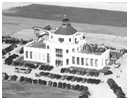
18 April 2009: The AIAA Historic Aerospace Sites Committee designated the Houston Municipal Airport Terminal, also known as the 1940 Air Terminal, at the William B. Hobby Airport, Houston, Texas, as a Historic Aerospace Site. A historic marker was unveiled at noon on 18 April 2009, as part of the annual “Hobbyfest” program. Read the press release for complete details. (Image: Hobby Air Terminal, 1940)
Vandenberg Air Force Base

30 March 2009: Vandenberg Air Force Base, California. Ceremony was held at 1:00 p.m. on 30 March 2009 to officially designate Vandenderg Air Force Base, California as a Historic Aerospace Site; reception immediately followed.
